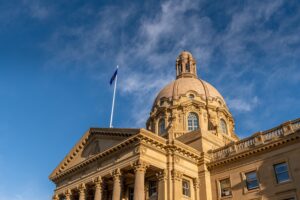Available in Audio Format:
Alberta has led the country in limiting medical transitioning for minors. And just last week, Alberta took another unprecedented step to protect the health and well-being of children: invoking the notwithstanding clause.
Early in 2024, Premier Danielle Smith announced that Alberta would take steps to restrict these interventions, which until then had no legal age restrictions. Her government’s Bill 26, the Health Statutes Amendment Act, contained provisions to ban “puberty suppression,” “hormone replacement therapy,” and “sex reassignment surgery” to treat gender dysphoria or gender incongruence for any minor under the age of 18.
Alberta took another unprecedented step to protect the health and well-being of children: invoking the notwithstanding clause.
Despite the legislation’s passage in late 2024, only the ban on surgeries is in force right now. The government has not brought into force the provisions that ban “hormone therapies.” The rationale for this delay was the promise to craft an exception to allow “minors aged 16 and 17 with parental, physician and psychologist approval” and “minors who have already been prescribed hormone replacement therapies” to receive these pharmaceuticals. Such an exception has yet to be drafted, with no explanation for the year-long delay. The government could have brought the law into force, but, for whatever reason, has not chosen to do so.
While the provincial government inexplicitly delayed, a new barrier arose that prevented the law from taking effect. This summer, Justice Allison G. Kuntz issued a preliminary injunction to prevent the ban on puberty blockers from coming into force, claiming that the law might infringe on Charter rights.
The government is already in the process of appealing this injunction, paving the way for the full ban on medical transitioning for minors to go into effect. But that legal process could take years, years in which hundreds of children and adolescents could be prescribed a medical transition.
And so, to bypass this potentially lengthy legal procedure, the government invoked the notwithstanding clause with Bill 9, the Protecting Alberta’s Children Statutes Amendment Act. The notwithstanding clause is a clause in the Canadian constitution that allows the elected parliament or legislature (rather than the courts) to be the final arbiter of whether a law violates certain sections of the Charter of Rights and Freedoms. With the ban on medical transitioning for minors shielded by the notwithstanding clause, the opinion of the courts remains just that: an opinion. Thus, a law could remain in effect despite a contrary opinion of the courts.
Once considered the nuclear option to resolve differences between courts and legislatures, this provision is experiencing a renaissance (outside of Quebec, which has a long history of using the clause). Ontario used the notwithstanding clause to amend election spending rules. Saskatchewan invoked the section to pre-empt legal challenges to its legislation requiring parental consent for their children’s attempt to change their name or pronouns at school. The federal Conservatives have repeatedly promised to use it to ensure that criminals are appropriately punished. And just last month, the Alberta government relied upon the notwithstanding clause to end a teacher’s strike.
The notwithstanding clause allows the elected parliament or legislature (rather than the courts) to be the final arbiter of whether a law violates certain sections of the Charter of Rights and Freedoms.
This is precisely what is needed to safeguard the health of young people and prevent these radical interventions. We know that over 1600 minors have visited Alberta’s two main pediatric gender clinics in the last five years. And we know that 36 minors have had gender surgeries over the past decade. Hundreds of children each year are being prescribed gender medicine.
This even though over 80% of cases of pre-pubescent gender dysphoria among children resolve naturally after puberty. When clinicians cannot tell with any certainty whether a young person will persist or desist in their gender dysphoria, the responsible option is to wait and see, rather than turning to medical interventions that prevent development or surgically remove healthy organs.
Rather than being cautious, clinicians in Canada are often far too quick to refer gender dysphoric children to the progression of medical transitioning. According to one study, over 62% of children and young adolescents referred to gender clinics in Canada were provided with hormones on the very first visit. Rather than providing kids time to think, taking puberty blockers sets children on the path of a further medical transition. As many as 98% of minors who take puberty blockers go on to take cross-sex hormones.
And while pro-transition advocates claim that these interventions are “medically necessary” to protect the health, well-being, and even the life of “gender diverse” young people, the evidence to back that claim up is sparse at best. The United Kingdom’s Cass Review and the United States’ Health and Human Services Review find that there is little to no high-quality or long-term evidence to support the benefits of medical transitioning for minors. Earlier this year, two Canadian studies found the same thing.
Alberta is taking the right step in invoking the notwithstanding clause to ensure that its restrictions on medical transitioning for minors go into effect.
For all of these reasons, Alberta is taking the right step in invoking the notwithstanding clause to ensure that its restrictions on medical transitioning for minors go into effect. Alberta is doing the hard part. But they need to do the easy part too. They need to proclaim the sections of the law that ban the provision of puberty blockers and cross-sex hormones.
Without these actions, the law is just a façade. It looks impressive, but it isn’t functional. Alberta needs to finish the job of banning medical transitioning for minors. Invoking the notwithstanding clause is one step towards that goal, but more remains to be done.
